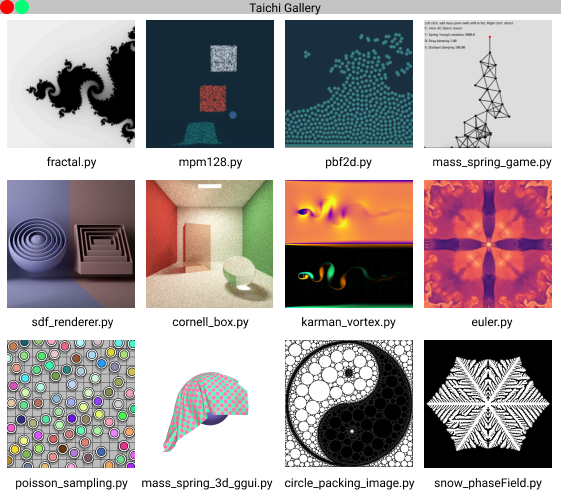Hello, World!
Taichi is a domain-specific language embedded in Python and designed specifically for high-performance, parallel computing.
When writing compute-intensive tasks in Python, you can take advantage of Taichi's high performance computation by following a few extra rules. Generally, Taichi provides two decorators @ti.func and @ti.kernel, which instruct Taichi to take over the tasks. Its just-in-time (JIT) compiler compiles the decorated functions to machine code, and all subsequent calls to these functions are executed on multi-core CPUs or GPUs. In a typical compute-intensive scenario, such as a numerical simulation, Taichi can accelerate performance by 50x~100x compared with native Python code.
Taichi also has a built-in ahead-of-time (AOT) system for exporting your code into binary/shader files, which can then be called in C/C++ and run without the Python environment. See the AOT deployment for more information.
Prerequisites
- Python: 3.7/3.8/3.9/3.10 (64-bit)
- OS: Windows, OS X, and Linux (64-bit)
Installation
Taichi is available as a PyPI package:
pip install taichi
Hello, world!
A basic fractal example, the Julia fractal, can be a good starting point for you to understand the fundamentals of the Taichi programming language.
import taichi as ti
import taichi.math as tm
ti.init(arch=ti.gpu)
n = 320
pixels = ti.field(dtype=float, shape=(n * 2, n))
@ti.func
def complex_sqr(z): # complex square of a 2D vector
return tm.vec2(z[0] * z[0] - z[1] * z[1], 2 * z[0] * z[1])
@ti.kernel
def paint(t: float):
for i, j in pixels: # Parallelized over all pixels
c = tm.vec2(-0.8, tm.cos(t) * 0.2)
z = tm.vec2(i / n - 1, j / n - 0.5) * 2
iterations = 0
while z.norm() < 20 and iterations < 50:
z = complex_sqr(z) + c
iterations += 1
pixels[i, j] = 1 - iterations * 0.02
gui = ti.GUI("Julia Set", res=(n * 2, n))
for i in range(1000000):
paint(i * 0.03)
gui.set_image(pixels)
gui.show()
Save the code above to your local machine and run this program.
You get the following animation:

Let's dive into this simple Taichi program.
Import Taichi
import taichi as ti
import taichi.math as tm
The first two lines import Taichi and its math module. The math module contains:
- Frequently-used math functions.
- Built-in vectors and matrices of small dimensions, such as
vec2for 2D real vectors andmat3for 3×3 real matrices. See the Math Module for more information.
ti.init(arch=ti.gpu)
This line calls ti.init() to customize your Taichi runtime depending on the arguments passed into it. For now, we only introduce the most important argument, namely, arch.
The argument arch specifies the backend that executes the compiled code. A backend can be either ti.cpu or ti.gpu. When ti.gpu is specified, Taichi moves down the backend list of ti.cuda, ti.vulkan, and ti.opengl/ti.metal. If no GPU architecture is available, Taichi falls back to your CPU device.
You can also directly specify which GPU backend to use. For example, set arch=ti.cuda to run your program on CUDA. Taichi raises an error if the target architecture is unavailable. See the Global Settings for more information about ti.init().
Define a field
Let's move on to the next two lines.
n = 320
pixels = ti.field(dtype=float, shape=(n * 2, n))
The code snippet defines a field whose shape is (640, 320) and whose elements are floating-point numbers.
field is the most important and frequently used data structure in Taichi. You can compare it to NumPy's ndarray or PyTorch's tensor. But Taichi's field is more flexible. For example, a Taichi field can be spatially sparse and easily switched between different data layouts.
We will introduce more advanced features of field in other scenario-based tutorials. For now, it suffices to know that the field pixels is a dense 2D array.
Kernels and functions
Lines 9~22 define two functions, one decorated with @ti.func and the other with @ti.kernel. They are called Taichi function and kernel respectively. Taichi functions and kernels are not executed by Python's interpreter but taken over by Taichi's JIT compiler and deployed to your parallel multi-core CPU or GPU.
The main differences between Taichi functions and kernels:
- Kernels are the entry points where Taichi kicks in and takes over the task. A kernel can be called anywhere, anytime in your program, while a Taichi function can be called only from inside a kernel or from inside another Taichi function. In the example above, the Taichi function
complex_sqris called by the kernelpaint. - A kernel must take type-hinted arguments and return type-hinted results. But Taichi functions do not require type hinting. In the example above, the argument
tin the kernelpaintis type hinted; the argumentzin the Taichi functioncomplex_sqris not. - Taichi supports nested functions but does not support nested kernels.
- Taichi does not support recursive Taichi function calls.
tip
For those who come from the world of CUDA, ti.func corresponds to __device__ and ti.kernel corresponds to __global__.
For those who come from the world of OpenGL, ti.func corresponds to the usual function in GLSL and ti.kernel corresponds to a compute shader.
Parallel for loops
The key to high performance lies in Line 15:
for i, j in pixels:
This is a for loop at the outermost scope in a Taichi kernel and thus is automatically parallelized.
Taichi offers a handy syntax sugar: It parallelizes any for loop at the outermost scope in a kernel. This means that you can parallelize your tasks using one plain loop, without the need to know thread allocation/recycling or memory management.
Note that the field pixels is treated as an iterator. As the indices of the field elements, i and j are integers falling in the ranges [0, 2*n-1] and [0, n-1], respectively. The pair (i, j) loops over the sets (0, 0), (0, 1), ..., (0, n-1), (1, n-1), ..., (2*n-1, n-1) in parallel.
Keep in mind that the for loops not at the outermost scope are not parallelized but handled serially:
@ti.kernel
def fill():
total = 0
for i in range(10): # Parallelized
for j in range(5): # Serialized in each parallel thread
total += i * j
if total > 10:
for k in range(5): # Not parallelized because it is not at the outermost scope
You can also serialize a for loop at the outermost scope using ti.loop_config(serialize=True). See Serialize a specified parallel for loop for more information.
WARNING
The break statement is not supported in parallelized loops:
@ti.kernel
def foo():
for i in x:
...
break # Error!
@ti.kernel
def foo():
for i in x:
for j in range(10):
...
break # OK!
Display the result
Lines 18~23 render the result on your screen using Taichi's built-in GUI System:
gui = ti.GUI("Julia Set", res=(n * 2, n))
# Sets the window title and the resolution
for i in range(1000000):
paint(i * 0.03)
gui.set_image(pixels)
gui.show()
The program iterates over pixels 1,000,000 times, and the fractal pattern stored in pixels is updated accordingly. Call gui.set_image() to set the window and gui.show() to display the synchronized result on your screen.
Key takeaways
Congratulations! After walking through the short example above, you have learned the most significant features of Taichi:
- Taichi compiles and runs Taichi functions and kernels on the specified backend.
- For loops at the outermost scope in a Taichi kernel are automatically parallelized.
- Taichi provides a flexible data container field, and you can use indices to loop over a field.
Taichi examples
The Julia fractal is one of the representative demos Taichi provides. To view more selected demos in Taichi gallery:
ti gallery
This window appears:

To access the full list of Taichi examples, run ti example. Other useful command lines:
ti example -p fractal/ti example -P fractalprints the source code of the fractal example.ti example -s fractalsaves the example to your current work directory.
Supported systems and backends
The following table lists the supported operating systems and the backends that Taichi supports on these platforms:
| platform | CPU | CUDA | OpenGL | Metal | Vulkan |
|---|---|---|---|---|---|
| Windows | ✔️ | ✔️ | ✔️ | N/A | ✔️ |
| Linux | ✔️ | ✔️ | ✔️ | N/A | ✔️ |
| macOS | ✔️ | N/A | N/A | ✔️ | ✔️ |
- ✔️: supported;
- N/A: not available
You are now ready to move on and start writing your own Taichi programs. See the following documents for more information about how to use Taichi in some of its typical application scenarios: